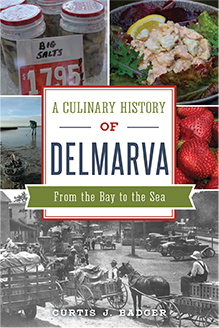Author Curtis Badger explores the culinary riches of the Peninsula in his new book
Review by Nick Brandi
Of all the things one can say about the Delmarva Peninsula, there is nothing that rings more true than that it has always fed its people — and fed them well. So well, in fact, that both a community and a culture were built around it, unifying a people who would no doubt tell you a couple of interesting things. One is that the peninsula does not belong to them but rather they to it. The other is that they belong to it more intimately than they do any of the three respective U.S. states to which they pay their taxes. Author Curtis Badger knows this and celebrates it in his new book,
A Culinary History of Delmarva: From the Bay to the Sea.
Badger grew up on the Eastern Shore in Virginia and graduated from Salisbury University with a bachelor’s degree in English. For four years, he was a member of the U.S. Air Force who worked as a photojournalist before returning to civilian life to begin a career that captured the Shore with his pen and camera.

“Remove the geopolitical boundaries — the state lines,” he writes, “and you find communities with a very close kinship and people who have many similarities in their in their history and culture…. Our lives are closely tied to the land and certainly to the water that surrounds us. We hunt and fish; we farm and raise corn and tomatoes in our gardens. We go clamming and crabbing. We enjoy being on the water and hate to contemplate life away from it.”
Beginning with fishing and the beautiful waters that bound the peninsula, Badger nimbly weaves back and forth in time, one minute recounting the extant Delmarva tradition of eating salted fish with bacon and eggs on Christmas morning — frying the roe from trout and croakers with the eggs — to Captain Samuel Argall, who reported back to England in 1610 that the barrier islands of Delmarva possessed “a great store of fish, both shellfish and other.”
From there, Badger repairs to terra firma, where he affectionately, yet not bathetically, describes the venerable hunter/gatherer traditions endemic to the region, channeling centuries-old echoes of marsh and tide, of father and sons, of men and their dogs, and of the majestic bounty of sacrifices that nature has made to sustain local families for countless generations. Along the way, you will meet everything from terrapins and muskrats to robin snipes and calico backs, along with all the usual-suspect shorebirds and other de rigueur waterfowl.
In Section III, titled “We Plow, We Propagate,” the author takes the readers to the fertile farmland of Delmarva, including hog farming, our produce and what we take to market. You will learn, for example, that according to a 1929 circular released by the U.S. Department of Agriculture, from 1920 to 1929, the four contiguous counties on the southern tip of Delmarva (Worcester, Somerset, Accomack and Northampton) produced more than 40% of the potatoes shipped by rail in the entire United States. That’s a lot of potatoes.
Add to this loving yet fascinating historical perspective a potpourri of recipes that include clams and crabs, chicken and muskrats — and, of course, scrapple and Old Bay, and what you’ll take away is a good homespun read that effectively lays the groundwork for an experience that is as deliciously filling as it is fulfilling.
A Culinary History of Delmarva: From the Bay to the Sea
By Curtis J. Badger
Arcadia Press (2021)
160 pages (pbk)

